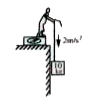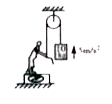A fire man has to carry an injured person of mass 40 kg from the top of a building with the help of the rope which can withstand a load of 100 kg. The acceleration of the fireman if his mass is 80 kg, will be-
8.17m/s2
9.8m/s2
1.63m/s2
17.97m/s2
The correct Answer is:3
To solve the problem, we need to analyze the forces acting on the fireman and the injured person while they are being lowered down by the rope.
1. Identify the Masses:
- Mass of the injured person (m1) = 40 kg
- Mass of the fireman (m2) = 80 kg
- Total mass (M) = m1 + m2 = 40 kg + 80 kg = 120 kg
2. Convert Mass to Weight:
- The weight of the injured person (W1) = m1 * g = 40 kg * 9.8 m/s² = 392 N
- The weight of the fireman (W2) = m2 * g = 80 kg * 9.8 m/s² = 784 N
- Total weight (W_total) = W1 + W2 = 392 N + 784 N = 1176 N
3. Determine the Maximum Tension in the Rope:
- The maximum load the rope can withstand = 100 kg
- Maximum tension (T_max) = 100 kg * g = 100 kg * 9.8 m/s² = 980 N
4. Apply Newton's Second Law:
- The net force (F_net) acting on the system when moving downward is given by:
Fnet=Wtotal−Tmax
- Substitute the values:
Fnet=1176N−980N=196N
5. Calculate the Acceleration of the System:
- According to Newton's second law, F_net = M * a, where M is the total mass and a is the acceleration.
- Rearranging gives:
a=FnetM
- Substitute the values:
a=196N120kg≈1.633m/s2
6. Conclusion:
- The acceleration of the fireman while carrying the injured person is approximately 1.633 m/s² downward.
- Mass of the injured person (m1) = 40 kg
- Mass of the fireman (m2) = 80 kg
- Total mass (M) = m1 + m2 = 40 kg + 80 kg = 120 kg
- The weight of the injured person (W1) = m1 * g = 40 kg * 9.8 m/s² = 392 N
- The weight of the fireman (W2) = m2 * g = 80 kg * 9.8 m/s² = 784 N
- Total weight (W_total) = W1 + W2 = 392 N + 784 N = 1176 N
- The maximum load the rope can withstand = 100 kg
- Maximum tension (T_max) = 100 kg * g = 100 kg * 9.8 m/s² = 980 N
- The net force (F_net) acting on the system when moving downward is given by:
Fnet=Wtotal−Tmax
- Substitute the values:
Fnet=1176N−980N=196N
- According to Newton's second law, F_net = M * a, where M is the total mass and a is the acceleration.
- Rearranging gives:
a=FnetM
- Substitute the values:
a=196N120kg≈1.633m/s2
- The acceleration of the fireman while carrying the injured person is approximately 1.633 m/s² downward.
Topper's Solved these Questions
- LAWS OF MOTION Book:VMC MODULES ENGLISHChapter:LAWS OF MOTION Exercise:ENABLE
Explore 50 Videos
- LAWS OF MOTION Book:VMC MODULES ENGLISHChapter:LAWS OF MOTION Exercise:EFFICIENT
Explore 50 Videos
- KINEMATICS OF A PARTICLE Book:VMC MODULES ENGLISHChapter:KINEMATICS OF A PARTICLE Exercise:JEE Advanced (archive)
Explore 14 Videos
- LIQUIDSBook:VMC MODULES ENGLISHChapter:LIQUIDSExercise:JEE ADVANCED (LEVEL -2)
Explore 55 Videos
Similar Questions
A person of mass 70 kg jump from a 3.0m height
View SolutionTwo painters are working from a wooden hoard 5m long suspended from the top of a building by two ropes attached to the ends of the plank. Either rope can withstand a maximum tension of 1040N. Painter A of mass 80kg is working at a distance of 1m from one end. Painter B of mass 60kg is working at a distance of x in from the centre of mass of the board on the other side. Take mass of the board as 20kg and g=10ms−2. The range of x so that both the painters can work safely is
View Solution
Knowledge Check
A rope is wound round a hollow cylinder of mass 3kgandradius40cm. If the rope is pulled with a force of 30N, what is the angualr acceleration of the cylinder ?
A15rads−2B20rads−2C25rads−2D30rads−2
A 50 kg man stuck in flood is being lifted vertically by an army helicopter with the help of light rope which can bear a maximum tension of 70 kg-wt. The maximum acceleration with which helicopter can rise so that rope does not breaks is (g=9.8ms−2)
View SolutionIn the figure shown the man of mass 60kg is lowering a block of mass 10kg with an acceleration of 2m/s2. Find the reading of the machine.

View SolutionIn the figure shown the man of mass 60kg is lowering a block of mass 10kg with an acceleration of 2m/s2. Find the reading of the machine.

View SolutionA man weighing 70 kg carries a 30 kg box to the top of a building 20 m high. Calculate the work done by the man (take g=9.8ms−2).
View SolutionA rope of negligible mass is wound around a hollow cylinder of mass 3kg and radius 40cm. What is the angular acceleration of the cylinder, if the rope is pulled with a force of 30N ? What is the linear acceleration of the rope ? Assume that there is no slipping.
View SolutionIn the figure shown the man of mass 60kg is liftinga block of mass 10kg with an acceleration of 5m/s2 . Find reading of the machine.

View SolutionA body of mass 50 kg and specific gravity force is to be lifted using a rope of breaking strength of 60 kg wt. The acceleration with which it can be pulled up in least interval of time
View Solution